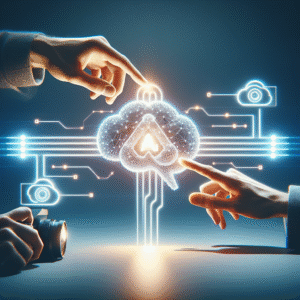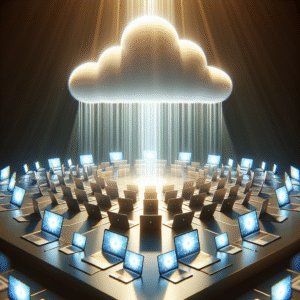What does the future hold for cybersecurity in our increasingly digital world?
Understanding Cybersecurity
Cybersecurity seems to be a buzzword that everyone’s talking about, but what does it really mean? At its core, cybersecurity involves protecting networks, systems, and programs from digital attacks. These cyber-attacks are designed to access, change, or destroy sensitive information, and they can disrupt the services we heavily rely on today.
As I think about this topic, I realize just how integral cybersecurity is to our daily lives. From online banking to social media, we are constantly interacting with various platforms that require us to trust in their security measures. Understanding the fundamental concepts of cybersecurity is essential as we navigate through a world increasingly defined by digital interactions.
The Importance of Cybersecurity Today
In recent years, the significance of cybersecurity has truly come into focus. With the rise of data breaches, identity theft, and other cybercrime, my concern for the safety of my personal information has grown.
Statistics That Speak Volumes
To emphasize the importance of cybersecurity, I often refer to some startling statistics:
| Statistic | Value |
|---|---|
| Number of recorded cybercrime incidents in 2022 | Approximately 900,000 |
| Estimated global cost of cybercrime by 2025 | $10.5 trillion |
| Percentage of breaches involving human error | 95% |
These numbers paint a clear picture that cyber threats are not only prevalent but also increasingly sophisticated. It reinforces my belief that everyone, from individuals to large corporations, must prioritize strong cybersecurity practices.
The Evolution of Cybersecurity
As technology evolves, so too must our strategies to protect it. I can’t help but reflect on how cybersecurity has changed over the years.
A Timeline of Key Developments
- 1980s: The emergence of computer viruses began, introducing the cybersecurity landscape to threats that had not existed before.
- 1990s: The introduction of the internet brought about e-commerce and online communication, prompting the need for security measures.
- 2000s: The rise of malware, spyware, and phishing scams made headlines, illuminating the need for awareness and protection.
- 2010s: The concept of “cybersecurity as a service” emerged, offering companies outsourced security solutions.
- 2020s: The Internet of Things (IoT) became mainstream, creating vast networks that require robust security protocols.
Reflecting on this timeline, I realize that cybersecurity isn’t a one-time effort but a continuous battle against evolving threats.
Current Cybersecurity Trends
Today, the field of cybersecurity is shaped by various trends that signal where we’re headed. I find it fascinating to observe how these trends evolve and what they mean for the future.
Rise of Artificial Intelligence and Machine Learning
As I learn more about technology, I’ve come to appreciate how artificial intelligence (AI) and machine learning are being used in cybersecurity. They help in analyzing vast amounts of data to detect anomalies and threats.
- Proactive Threat Detection: AI can identify unusual patterns that might indicate a breach before it escalates.
- Automated Response Mechanisms: Machine learning algorithms can respond to incidents in real-time, reducing the window of vulnerability.
The incorporation of AI into cybersecurity practices makes sense, given how quickly threats can manifest and how important it is to respond swiftly.
Increased Focus on Zero Trust Security
The concept of Zero Trust Security is another trend I can’t ignore. It’s based on the principle of “never trust, always verify.”
| Key Principles | Description |
|---|---|
| User Identity Verification | Every user must be authenticated, regardless of their location. |
| Device Security Checks | Every device that accesses the network needs to meet defined security standards. |
| Least Privilege Access | Users are granted only the permissions necessary for their roles. |
The Zero Trust model resonates with me because it acknowledges the reality that threats can originate from both inside and outside an organization.
The Challenges Ahead
Despite the advancements in cybersecurity, challenges remain that concern me deeply.
The Skills Gap in Cybersecurity
One of the most pressing problems in this field is the skills shortage. There simply aren’t enough trained professionals to meet the rising demand for cybersecurity experts. I often wonder how this could impact the security of our digital assets.
- Entry barriers: Complex certification processes and high costs deter many from pursuing careers in cybersecurity.
- Need for Continuous Learning: The rapidly changing threat landscape necessitates that cybersecurity professionals have ongoing training, which can be demanding.
The Cost of Cybersecurity
Investing in robust cybersecurity measures can be costly, which often leads to budget constraints, especially for small businesses. I understand that striking a balance between adequate protection and affordability can be a daunting task.
| Expense Components | Description |
|---|---|
| Security Software | Costs associated with various security tools. |
| Employee Training | Investment in educating staff about cybersecurity practices. |
| Incident Response Plans | Budgeting for contingency measures in case of breaches. |
The financial aspect is crucial, and it makes me wonder how many organizations are underprepared due to cost constraints.
The Role of Legislation
As someone who values privacy, I believe that legislation plays a significant role in shaping the future of cybersecurity.
Emerging Cybersecurity Laws
In regions like Europe, the General Data Protection Regulation (GDPR) has set standards for data protection. This regulation enforces strict guidelines on how data is collected, processed, and stored, ultimately putting more control in the hands of individuals.
The implications of such laws extend beyond compliance; they encourage organizations to adopt better cybersecurity practices.
International Cooperation
The increasing interconnectedness of our world necessitates international cooperation in addressing cyber threats. As I think about the global landscape, I acknowledge that no one nation can tackle this issue alone.
- Collaborative Efforts: Countries must work together to share information about threats and best practices.
This cooperation holds great promise for fostering a safer digital world.
The Future of Cybersecurity Technologies
Predicting the future of cybersecurity technologies is exciting yet challenging.
Quantum Computing and Its Implications
Quantum computing is a powerful force on the horizon, with the potential to revolutionize how we approach data encryption and protection.
- Enhanced Encryption: I am curious how quantum technology can provide more sophisticated encryption methods, making it increasingly difficult for unauthorized entities to access sensitive information.
- New Threats: However, it also presents challenges, as cybercriminals may leverage these technologies for malicious purposes.
This duality highlights the ongoing need for adaptive cybersecurity strategies.
Adaptation of Blockchain Technology
Blockchain technology has caught my attention due to its promises of transparency and trust.
- Data Integrity: The inherent properties of blockchain can help secure records and transactions, making them tamper-proof.
- Decentralization: By removing the need for a central authority, blockchain reduces vulnerability to single points of failure.
As I ponder this technology, I realize that its integration into cybersecurity methodologies could reshape our approach to protecting data.
Personal Cybersecurity Practices
As someone who is conscious of my online presence, I believe that personal cybersecurity is just as crucial as corporate measures. Below are some practical steps that I follow:
Strong Password Practices
Creating strong, unique passwords is foundational. I use a combination of letters, numbers, and special characters and never reuse passwords across different platforms.
Two-Factor Authentication
Enabling two-factor authentication (2FA) on my accounts adds an extra layer of protection. It requires an additional verification step, which I find reassuring.
Regular Software Updates
Keeping my devices updated is essential. Software updates often include security patches that protect against emerging threats, so I make it a point to check for updates regularly.
| Practice | Description |
|---|---|
| Password Managers | Using dedicated software to manage secure passwords. |
| Backup Data | Regularly backing up important files to external drives or cloud services. |
By adopting these practices, I feel more confident about safeguarding my personal information.
The Future Workforce in Cybersecurity
Looking ahead, I see a future workforce in cybersecurity that must be adaptable, skilled, and diverse.
Training and Education
Educational institutions are beginning to realize the importance of cybersecurity and are tailoring their programs accordingly. I believe a more robust pipeline of trained professionals will soon emerge, better prepared to tackle evolving challenges.
- Hands-On Experience: Internships and co-op programs provide students with valuable real-world experience.
- Interdisciplinary Approaches: Combining knowledge from different fields, such as technology and law, will be essential for understanding the complexities of cybersecurity.
Embracing Diversity
Another aspect I find crucial is the push for diversity within the cybersecurity workforce. Different backgrounds and perspectives can lead to innovative problem-solving approaches.
- Encouraging Women and Minorities: Efforts are being made to encourage underrepresented groups to enter the field, which I wholeheartedly support.
I am convinced that diversity will only strengthen our capabilities in protecting our digital landscape.
Conclusion
Reflecting on everything I’ve gathered about the future of cybersecurity in our digital world, I realize that it’s an ever-evolving landscape and one that demands our attention. As we move forward, I feel a sense of responsibility to be more informed and proactive about protecting my digital footprint.
From understanding the challenges and trends in cybersecurity to adopting better personal practices, I know that each step can contribute to a more secure digital world for all of us. Cybersecurity isn’t just a concern for organizations; it’s a personal commitment I am willing to uphold.
The future may be unpredictable, but I remain optimistic that, through education, cooperation, and technological advancement, we can create a safer environment for our digital lives. I look forward to seeing how we all play a role in shaping a secure future together.






